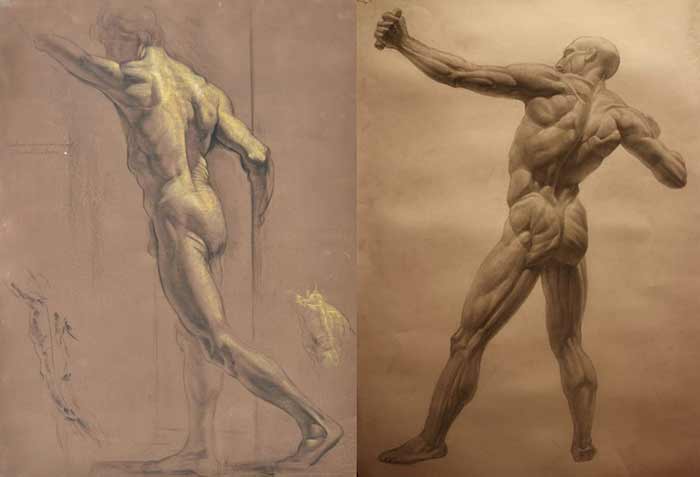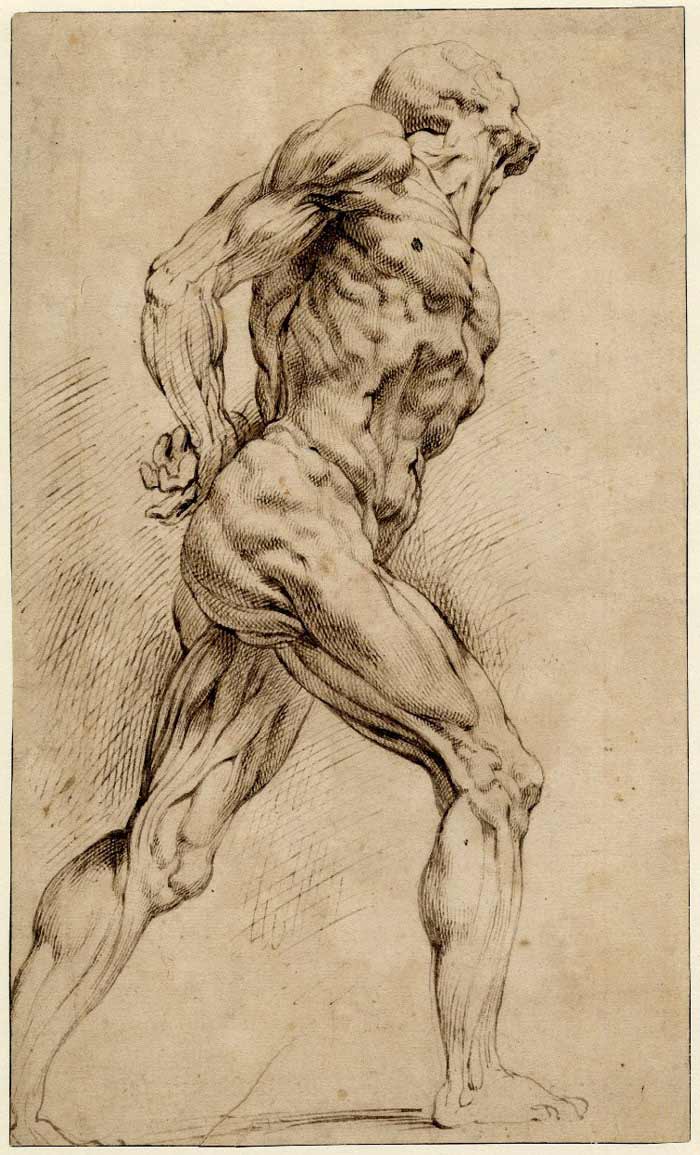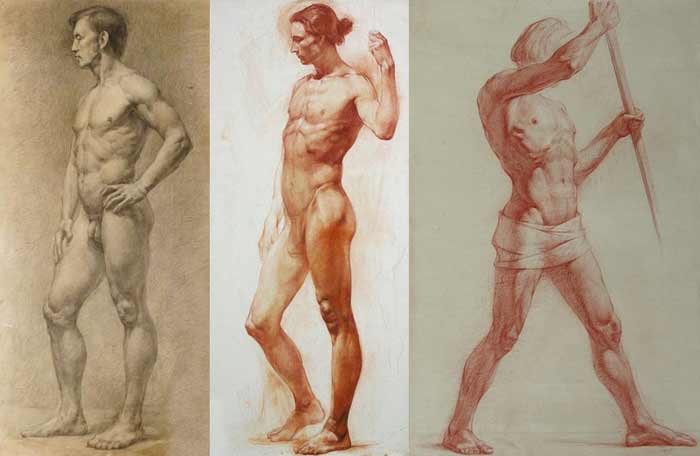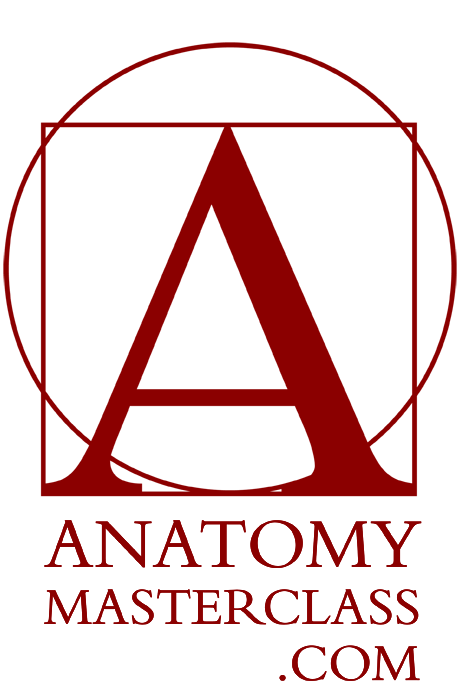Leg Muscle Anatomy
Leg Muscle Anatomy
Anatomy Lesson 12 – Part 5
In this video lesson, you will discover the leg muscle anatomy.
Leg Muscle Anatomy for Figurative Artists
Let’s begin with the skeletal anatomy.
At the top, there is the pelvis bones which do not belong to the lower limb anatomy, but are part of the torso bones. The pelvis consists of the ilium bones, the sitting bones, the pubic bone, and the sacrum.
The thighbone bone is connected to the pelvis via a hip joint. This bone is slightly arched forward. At its bottom edge, this bone ends in the cylindrical shape of the condyle. This rounded surface is part of the knee joint.
The thighbone is supported by the shinbone, which is the lower leg bone.
The upper part of the shinbone is referred to as the condyle of the tibia.
Just below the knee, in the front, there is the tibial tuberosity, which is an important landmark for a fine artist.
Next to the shinbone, there is another bone of the lower leg. It is called the fibula, or clafbone.
The lower end of the shinbone is higher than the end of the calfbone.
When you draw legs, it is important to remember that the inner ankle is higher than the outer one.




Leg Muscle Anatomy
It is time to review the leg muscle anatomy.
The buttocks muscle, which is called the gluteus maximus, starts from the back edge of the pelvis and inserts into the upper part of the thighbone. This muscle is part of the gluteal group which consists of three muscles. The gluteus maximus is the most powerful of the three muscles. It moves the thigh backward and also assists in rotating the upper leg outward.
Another muscle of this group is the gluteus medius. It starts from the outer surface of the ilium bone of the pelvis and inserts into the upper edge of the thigh bone. This muscle moves the upper leg sideways and away from the body and also assists in the medial rotation of the upper leg.
The front portion of the thigh is occupied by the quadriceps muscle. The outer head of this muscle originates from the upper edge of the thigh bone and goes downward to the knee cap. The frontal head of the quadriceps muscle starts from the pelvis. Together with other heads, it travels to the knee cap and then downward to the tibial tuberosity. The main action of this muscle group is to extend the lower leg at the knee and to flex the thigh at the hip joint.
At the back side of the thigh, there is the hamstring group of muscles. These three muscles begin from the sitting bone and insert into the outer and inner condyles of the shinbone and into the head of the calfbone. The main action of the hamstring group is to extend, or straighten, the thigh at the hip joint. It also flexes, or bends, the leg at the knee joint.
There are ligaments located in the knee joint. This strong tissue holds together the upper and lower leg bones (the femur and the tibia).
At the outer side of the thigh, there is a fibrous, flat strap which is called the ilio-tibial tract. It begins with the gluteal group of muscles and inserts into the outer condyle of the tibia which is at the upper outer edge of the shin bone.
The calf muscle is located on the back side of the lower leg. It has two portions. They start from the back surfaces of the condyles of the femur and go downward to join the common tendon which inserts into the heel bone. This muscle flexes the lower leg at the knee and also rotates the foot downward.
Underneath the calf muscle, there is a fish-shaped muscle which is called soleus. It goes from the shinbone and the calfbone and inserts, together with the calf muscle, into the heel bone. It engages in actions similar to the calfmuscle.
There are two long muscles on the outer side of the calfbone. They help move the foot downward and assist in turning the sole of the foot outward. These muscles also stabilize the outer ankle and assist in supporting the arches of the foot.
On the outer side of the lower leg, there is another muscle which begins from the top edge of the shinbone and inserts into the phalanges of the foot toes. Tendons of this muscle are noticeable when toes of the foot are raised or spread apart.
On the front side of the lower leg, there is the shin muscle. It goes from the top of the shin bone and inserts into the middle of the foot near the big toe. The main action of this muscle is to lift the foot upward when walking. Its cord-like tendon is noticeable, on the surface near the ankle, when the foot is flexed upward.
The shin bone is quite close to the front surface of the lower leg. In fact, part of it is not covered by muscles and you can easily feel this bone under your fingers when touching the lower leg.
Unlike the shinbone, the thighbone is deeply immersed in the mass of the muscles of the upper leg.
To realistically depict the lower limbs, you need to keep in mind their angles. As seen on the front, there are several angles:
- the angle of the quadriceps muscles
- the angle of the calf muscles
- and the angle of the ankle bones
When drawing the lower limbs, you also need to remember that the direction of the thigh goes inward; it changes its direction at the knee area, and once again travels inward along the lower leg.
There is also the “S” shape you have to keep in mind. It starts from the front top edge of the pelvis, travels along the tailor’s muscle, changes its curvature at the knee, and follows the shinbone bone to the inner ankle.
Another “S” shape is present on the side view. It also starts from the front edge of the pelvis, goes along the quadriceps muscle, changes its curvature at the knee, and follows the calf muscle along the Achilles tendon toward the heel…
[ The full lesson is avaibale to Anatomy Master Class members ]
To learn more about the Leg Muscle Anatomy, enroll in the Anatomy Master Class
Simple Pricing, No Surprises
One-time payment - Only $97 USD
ENROLL NOW



